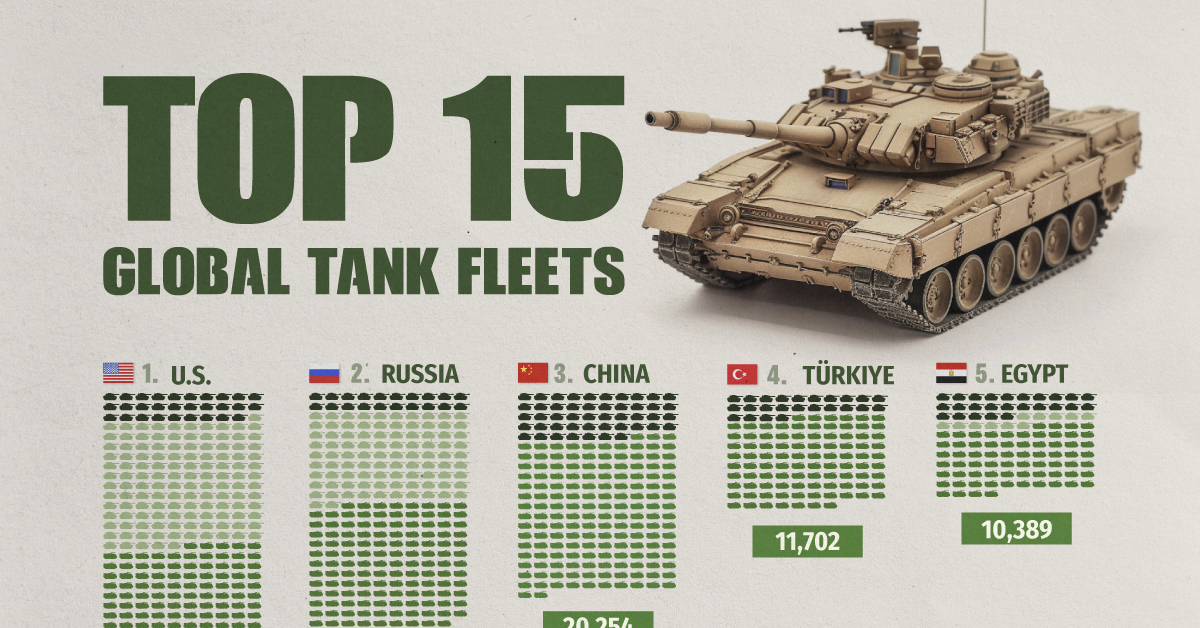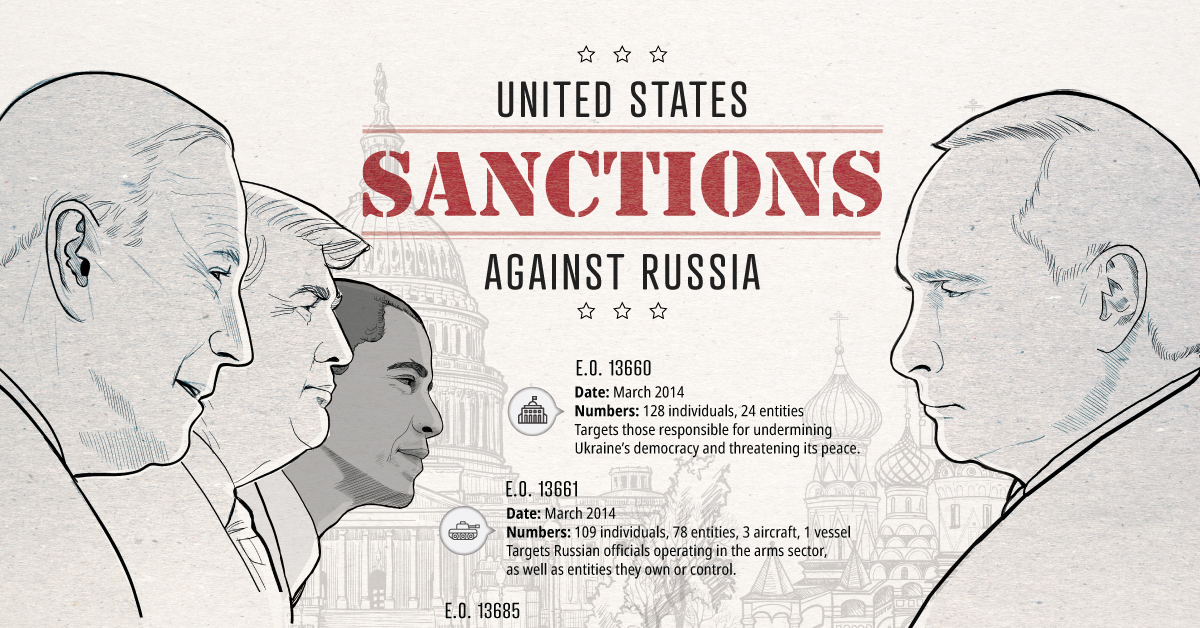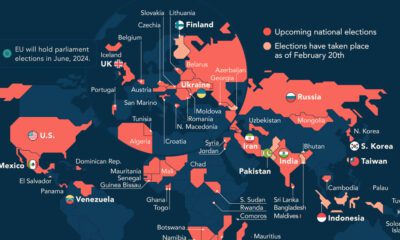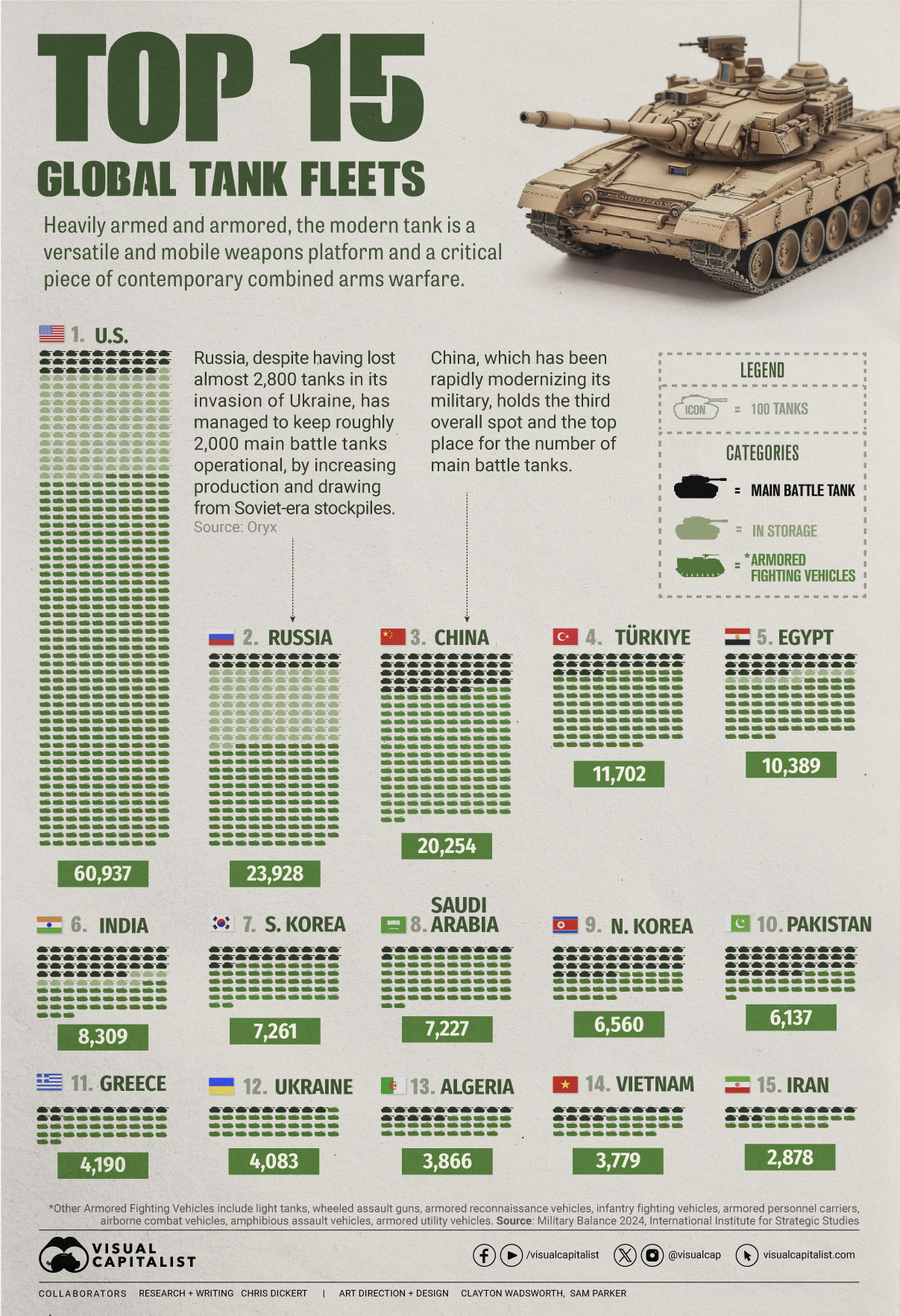Politics
A Recent History of U.S. Sanctions on Russia

A Recent History of U.S. Sanctions Against Russia
When a direct military confrontation is off the table, how should countries respond to acts of foreign aggression?
One tactic is sanctioning, which applies economic restrictions on a country’s government, businesses, and even individual citizens. In theory, these penalties create enough impact to dissuade further hostility.
Today, the U.S. maintains more sanctions than any other country, and one of its most comprehensive programs is aimed at Russia. To learn more, we’ve compiled an overview of these sanctions using data from the Congressional Research Service and U.S. Treasury.
Sanctions by Catalyst Event
Sanctions are often introduced after a President issues an executive order (EO) that declares a national emergency. This provides special powers to regulate commerce with an aggressor nation.
Our starting point will be Russia’s 2014 invasion of Ukraine, as this is where a majority of ongoing sanctions have originated.
Catalyst: 2014 Ukraine Invasion
On March 18, 2014, Russia annexed Crimea from Ukraine. This was denounced by the U.S. and its allies, leading them to impose wide-reaching sanctions. President Obama’s EOs are listed below.
| Executive order (EO) | Date of sanctions | Purpose |
|---|---|---|
| EO 13660 | March 2014 | Targets those responsible for undermining Ukraine’s democracy |
| EO 13661 | March 2014 | Targets Russian officials operating in the arms sector |
| EO 13662 | March 2014 | Targets those operating in Russia’s financial, energy, and defense sectors |
| EO 13685 | December 2014 | Prohibits U.S. business in occupied Crimea |
Altogether, these sanctions affect 480 entities (includes businesses and government agencies), 253 individuals, 7 vessels, and 3 aircraft.
Sanctions against ships and planes may seem odd, but these assets are often owned by sanctioned entities. For example, in February 2022, France seized a cargo ship belonging to a sanctioned Russian bank.
Catalyst: U.S. Election Interference
The Obama, Trump, and Biden administrations have all imposed sanctions against Russia for its malicious cyber activities.
| Executive order (EO) | Date of sanctions | Purpose |
|---|---|---|
| EO 13757 | December 2016 | Targets those who aim to interfere with the election process |
| EO 13848 | September 2018 | Targets those that have engaged in foreign interference of a U.S. election |
| EO 13849 | September 2018 | Expands the scope of previous sanctions |
| EO 14024 | April 2021 | Targets those engaged in malicious cyber activities on behalf of the Russian government |
Altogether, these sanctions affect 106 entites, 136 individuals, 6 aircraft, and 2 vessels. A critical target is the Internet Research Agency (IRA), a Russian company notorious for its online influence operations.
Prior to the 2016 election, 3,000 IRA-sponsored ads reached up to 10 million Americans on Facebook. This problem escalated in the run-up to the 2020 election, with 140 million Americans being exposed to propaganda on a monthly basis.
Catalyst: Various Geopolitical Dealings
The U.S. maintains various sanctions designed to counteract Russian influence in Syria, Venezuela, and North Korea.
| Executive order (EO) | Date of sanctions* | Purpose |
|---|---|---|
| EO 13582 | January 2018, November 2018, September 2019 | Targets those who provide material support to the government of Syria |
| EO 13850 | March 2019, March 2020, January 2021 | Targets financial institutions providing support to the government of Venezuela |
| EO 13810 | August 2018, September 2018 | Targets those who engage in significant transactions with North Korea |
| EO 13382 | June 2019, January 2022 | Targets those who contribute to the proliferation of weapons of mass destruction |
| EO 13722 | November 2020 | Targets those who trade raw materials or software with the government of North Korea |
*These are recent sanctions pursuant to EOs that were issued many years prior. For example, EO 13582 was introduced in August 2011.
These sanctions impact 23 entities, 17 individuals, and 7 vessels. Specific entities include Rosoboronexport, a state-owned arms exporter which was sanctioned for supplying the Syrian government.
As of December 2020, Syria’s government was responsible for the deaths of 156,329 people (civilians and combatants) in the civil war.
Catalyst: Chemical Poisonings of Individuals
The Russian government has been accused of poisoning two individuals in recent years.
The first incident involved Sergei Skripal, a former Russian intelligence officer who was allegedly poisoned in March 2018 on UK soil. The second, Alexei Navalny, a Russian opposition leader, was allegedly poisoned in August 2020.
The Chemical and Biological Weapons Control and Warfare Elimination Act of 1991 (CBW Act) allows sanctions against foreign governments that use chemical weapons. Nine individuals and five entities were sanctioned as a result of the two cases.
Catalyst: 2022 Ukraine Invasion
The U.S. has introduced many more sanctions in response to Russia’s latest invasion of Ukraine.
EO 14024, which was issued in February 2022, targets Russia’s major financial institutions and their subsidiaries (83 entities in total). Included in this list are the country’s two largest banks, Sberbank and VTB Bank. Together, they hold more than half of all Russian banking assets.
Also targeted are 13 private and state-owned companies deemed to be critical to the Russian economy. Included in this 13 are Rostelecom, Russia’s largest digital services provider, and Alrosa, the world’s largest diamond mining company.
Do Sanctions Work?
Proving that a sanction was solely responsible for an outcome is impossible, though there have been successes in the past. For example, many agree that sanctions played an important role in ending Libya’s weapons of mass destruction programs.
Critics of sanctions argue that imposing economic distress on a country can lead to unintended consequences. One of these is a shift away from the U.S. financial system.
There is no alternative to the dollar and no export market as attractive as the United States. But if Washington continues to force other nations to go along with policies that they consider both illegal and unwise … they are likely to shift away from the United States’ economy and financial system.
Jacob J. Lew, Former Secretary of the Treasury
In other words, sanctions can create an impact as long as the U.S. dollar continues to reign supreme.
War
Visualized: Top 15 Global Tank Fleets
Heavily armed and armored, the modern tank is a versatile and mobile weapons platform, and a critical piece of contemporary warfare.

The Top 15 Global Tank Fleets
This was originally posted on our Voronoi app. Download the app for free on iOS or Android and discover incredible data-driven charts from a variety of trusted sources.
Heavily armed and armored, the modern tank is a versatile and mobile weapons platform, and a critical piece of contemporary warfare.
This visualization shows the top 15 global tank fleets, using data from the 2024 Military Balance report from the International Institute for Strategic Studies (IISS).
Let’s take an in-depth look at the top three fleets:
1. United States
As the world’s pre-eminent military power, it’s perhaps no surprise that the United States also has the largest tank fleet, by a wide margin.
In total, they have just over 45,000 armored fighting vehicles in operation, along with 2,640 main battle tanks (MBTs), and 12,800 vehicles in storage, of which 2,000 are main battle tanks.
| Category | Vehicles | Global rank |
|---|---|---|
| Main battle tanks | 2,640 | 4 |
| Armored reconnaissance | 1,745 | 1 |
| Infantry fighting vehicles | 3,262 | 3 |
| Armored personnel carriers | 10,644 | 1 |
| Amphibious assault vehicles | 1,401 | 1 |
| Armored utility vehicles | 28,445 | 1 |
| Storage | 12,800 | 1 |
| Total | 60,937 | 1 |
The U.S. is internalizing the lessons from the ongoing invasion of Ukraine, where Western-supplied anti-tank weapons and massed Ukrainian artillery have been cutting Russian tanks to pieces. As a result, the U.S. recently canceled an upgrade of the M1 Abrams in favor of a more ambitious upgrade.
Meanwhile, the U.S. is nervously eyeing a more confident China and a potential clash over Taiwan, where air and naval forces will be critical. However, a recent war game showed that Taiwanese mechanized ground forces, kitted out with American-made tanks and armored fighting vehicles, were critical in keeping the island autonomous.
2. Russia
According to Oryx, a Dutch open-source intelligence defense website, at time of writing, Russia has lost almost 2,800 main battle tanks since invading Ukraine. Considering that in the 2022 edition of the Military Balance, Russia was estimated to have 2,927 MBTs in operation, those are some hefty losses.
Russia has been able to maintain about 2,000 MBTs in the field, in part, by increasing domestic production. Many defense plants have been taken over by state-owned Rostec and now operate around the clock. Russia is also now spending a full third of their budget on defense, equivalent to about 7.5% of GDP.
At the same time, they’ve also been drawing down their Soviet-era stockpiles, which are modernized before being sent to the front. Just how long they can keep this up is an open question; their stockpiles are large, but not limitless. Here is what their storage levels look like:
| Category | 2023 | 2024 | YOY change |
|---|---|---|---|
| Main battle tanks | 5,000 | 4,000 | -20.0% |
| Armored reconnaissance | 1,000 | 100 | -90.0% |
| Infantry fighting vehicles | 4,000 | 2,800 | -30.0% |
| Armored personnel carriers | 6,000 | 2,300 | -61.7% |
| Total | 16,000 | 9,200 | -42.5% |
3. China
China holds the third overall spot and top place globally for the number of main battle tanks in operation. Untypically, the People’s Liberation Army has no armored vehicles in storage, which perhaps isn’t surprising when you consider that China has been rapidly modernizing its military and that stockpiles usually contain older models.
China also has one of the world’s largest fleets of armored fighting vehicles, second only to the United States. Breaking down that headline number, we can also see that they have the largest number of light tanks, wheeled guns, and infantry fighting vehicles.
| Category | Vehicles | Global rank |
|---|---|---|
| Main battle tanks | 4,700 | 1 |
| Light tanks | 1,330 | 1 |
| Wheeled guns | 1,250 | 1 |
| Infantry fighting vehicles | 8,200 | 1 |
| Armored personnel carriers | 3,604 | 5 |
| Airborne combat vehicles | 180 | 2 |
| Amphibious assault vehicles | 990 | 2 |
| Total | 20,254 | 3 |
This is equipment that would be integral if China were to make an attempt to reunify Taiwan with the mainland by force, where lightly armored mechanized units need to move with speed to occupy the island before Western allies can enter the fray. It’s worth noting that China also has one of the world’s largest fleets of amphibious assault vehicles.
End of the Tank?
Many commentators at the outset of Russia’s invasion of Ukraine, were quick to predict the end of the tank, however, to paraphrase Mark Twain, reports of the tank’s demise are greatly exaggerated.
With the U.S. and China both developing remote and autonomous armored vehicles, tanks could be quite different in the future, but there is nothing else that matches them for firepower, mobility, and survivability on the modern battlefield today.
-

 Real Estate2 weeks ago
Real Estate2 weeks agoVisualizing America’s Shortage of Affordable Homes
-

 Technology1 week ago
Technology1 week agoRanked: Semiconductor Companies by Industry Revenue Share
-

 Money1 week ago
Money1 week agoWhich States Have the Highest Minimum Wage in America?
-

 Real Estate1 week ago
Real Estate1 week agoRanked: The Most Valuable Housing Markets in America
-

 Business1 week ago
Business1 week agoCharted: Big Four Market Share by S&P 500 Audits
-

 AI1 week ago
AI1 week agoThe Stock Performance of U.S. Chipmakers So Far in 2024
-

 Misc2 weeks ago
Misc2 weeks agoAlmost Every EV Stock is Down After Q1 2024
-

 Money2 weeks ago
Money2 weeks agoWhere Does One U.S. Tax Dollar Go?


















